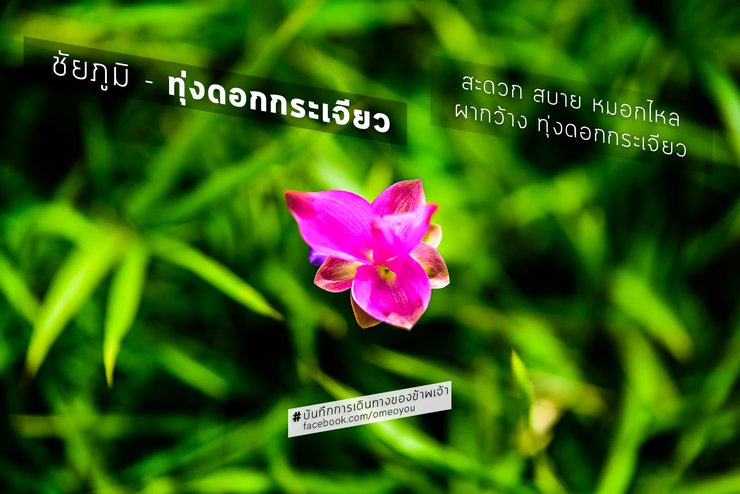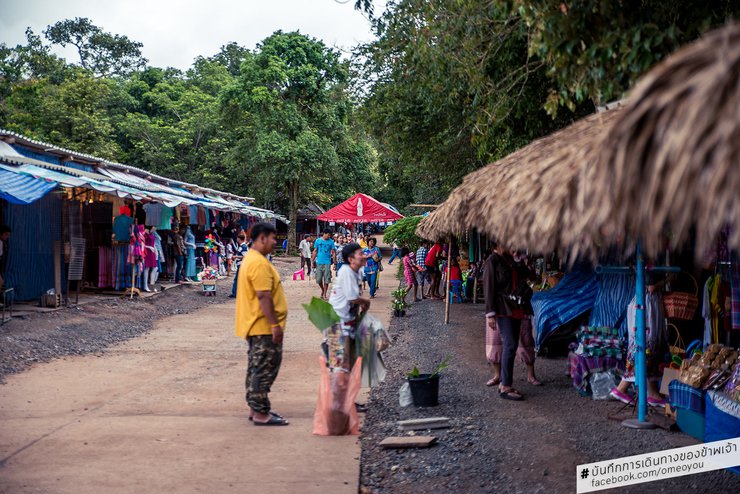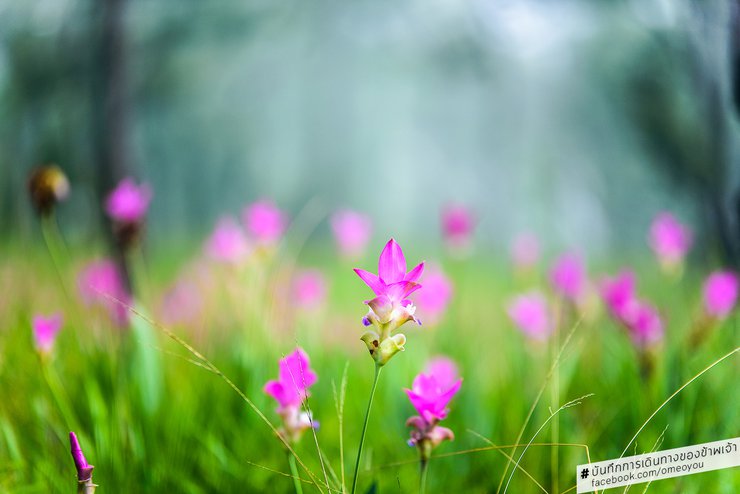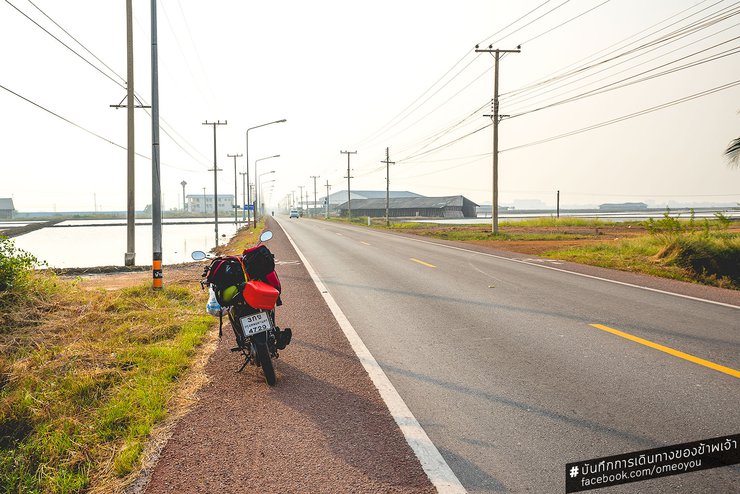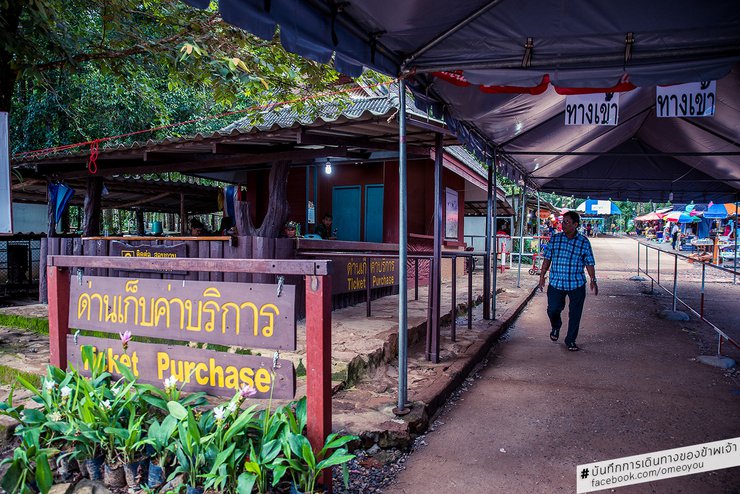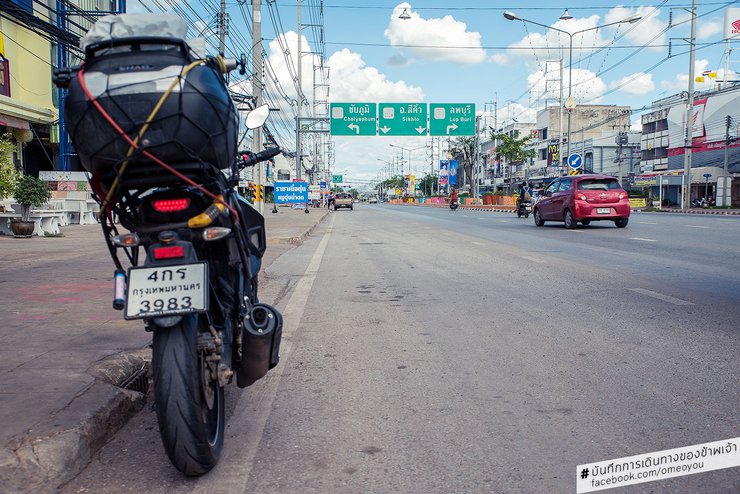
Children can play, adults can relax, and teenagers can enjoy themselves in the large park at the Pa Hin Ngam National Park.

Table of Contents
*** Reflecting on the Destination of the First Journey
Today's Goals
Stuck in traffic in Bangkok
The Bustling Tourist Season at Pa Hin Ngam
*** Renting a tent in a national park
*** The convenience that makes Pa Hin Ngam National Park is a magnificent garden.
*** When is the best time to visit here?
*** Preparation and recommendations for visiting this place
*** Summary of my expenses

Siam tulip (Curcuma alismatifolia) is a herbaceous perennial plant in the ginger family (Zingiberaceae). It blooms during the rainy season.
Commemorating the destination of the first trip
They say that the first time will be something that is easily remembered and difficult to forget. It should be true when I think back to my first trip, which took place almost a year ago at the end of the rainy season. With Chaiภูมิ, the field of siam tulips in the Thung Salaeng Luang National Park, where I didn't even see a single stem of siam tulips.

The Yamaha Spark 115i, pictured here in its early days when it still took us everywhere, is now in the care of my younger sister.
In the Past: A Journey of Uncertainty and Growth
The first journey was fraught with uncertainty and anxiety. The slow-moving car, the hesitation to overtake trucks, the fear of falling behind the group, and the looming darkness upon arrival all contributed to a sense of chaos. The absence of park rangers and fellow travelers only amplified the feeling of unease. To top it off, the season had passed, and the coveted wildflowers were nowhere to be seen. The result: a return home the next day.
However, the slow ride back to Bangkok on a Yamaha Spark 115i, with the morning freshness filling the air, sparked a newfound appreciation for travel. This single experience became the driving force behind countless future journeys. The realization dawned: "I love traveling outside Bangkok, especially in the mornings, amidst the forests and mountains."
This trip was rather rushed, unsure of how many nights were needed (but ended up staying only one night). The plan was to write an article about two national parks known for their fields of siam tulips: Pa Hin Ngam and Sai Thong.
However, I only stayed for one night and decided to review only the Pha Hin Ngam National Park for now. As I have a trip to Huai Kha Khaeng from the 12th to the 14th, I need to return to prepare.
Today's Destination: From Sai Thong to Pa Hin Ngam
While our original plan was to visit Sai Thong, we opted for the more convenient Pa Hin Ngam National Park. This park boasts well-maintained nature trails, making for a comfortable and safe hike without the worry of slippery or muddy terrain. Additionally, Pa Hin Ngam offers convenient transportation options for tourists, with numerous shuttle services available. (Though I heard Sai Thong also has such services, during my previous visit during the off-season, it was eerily quiet due to the lack of tourists.)
This time, I rode a Yamaha M-Slaz, a slightly larger and heavier version of the Spark 115i I used previously. Despite the increased size and weight, the journey from Bangkok to Pa Hin Ngam National Park was effortless thanks to the well-paved roads leading directly to the park.
Another advantage of the M-Slaz is the elimination of the need to open the seat for refueling, unlike the Spark 115i, where my packed luggage often required unloading and reloading during fuel stops. Additionally, the M-Slaz boasts a significantly larger fuel tank compared to the Spark 115i, reducing the frequency of refueling and eliminating the need for carrying a spare fuel container. In fact, since switching to the M-Slaz, I haven't needed to use the spare fuel container at all.
Furthermore, when cruising at speeds below 80 kilometers per hour, the M-Slaz delivers impressive fuel efficiency, achieving approximately 50 kilometers per liter during leisurely rides outside the city.

The M-Slaz owner carried a tent, bedding, small cooking equipment, and photographic equipment on their trip to Phu Lom Lo. Despite the heavy load, they still managed to ride the challenging and steep off-road trails to Phu Khieo on their return journey.
Stuck in traffic in Bangkok
I left Bangkok by visiting my sister near Ramkhamhaeng first. Until noon, I set off and let the GPS guide me, but I didn't check the route carefully beforehand. Traffic jams were something I had prepared for, but I felt anxious while driving because even though I was born in Bangkok, I hardly remember the routes in Bangkok. I have always used my mobile phone for navigation. When I left Ramkhamhaeng, the GPS took me to Highway 9. It looked like there would be a toll, and I don't come to this area often. I wasn't sure if there was a side road, so I turned into the city, circled around, and got lost in the traffic jam. It wasn't until one o'clock in the afternoon that I finally got out of the Bangkok area.
M-Slaz on this trip packed less because he didn't bring a tent, bedding, or kitchen equipment. However, he did bring a few more camera accessories, which he managed to cram into the rear box, although it was quite crowded. He kept the camera body with a 24-70mm lens attached on him at all times.
The journey begins with a long drive on major roads, including Highway 1 and Highway 21, until reaching Lopburi. From there, the route transitions to smaller roads, which are also in good condition. The total travel time, including rest stops, should not exceed four hours. Some drivers may even complete the journey in three hours, covering a distance of approximately 300 kilometers.
While there were several scenic spots along the way that tempted me to stop for photos, I ultimately decided to push on without stopping. My calculations indicated that I would likely arrive at the national park in the late afternoon, leaving little time for exploration and capturing the sunset. Capturing the sunset and gathering sufficient data in the evening would potentially allow me to return home earlier and prepare for my next trip.
Old Review Thread: Terraced Rice Fields, Mountains, Mist, Earth and Water Scent, Starlight and Sunrise - Ban Pa Bong Piang - Chiang Mai (http://pantip.com/topic/35452677)
Live recording on July 6-7, 2016 [Phi Ta Khon, a scary but playful mask, to bring away suffering] (http://pantip.com/topic/35357253)
Live recording June 30 - July 3, 2016 [Chiang Khan in the rainy season, fog, smiling at each other] (http://pantip.com/topic/35345418)
Live recording on June 29, 2016 [Loei Province, Phu Bo Bit, rainy season, fog and stars on the ground] (http://pantip.com/topic/35329482)
Live Recording June 28, 2016 Loei City: Lost, Fun, Tired, Wet, Impressed by Kindness
Live recording June 25-26, 2016 [First visit to Loei, impressed by the skywalk] (http://pantip.com/topic/35316607)
Giant water lilies, Tak Ta Wan, Talay Noi, water buffalo, migratory birds, Lamphu tree - Talay Noi - Phatthalung (http://pantip.com/topic/34977668)
The serene wooden bridge, a testament to the Mon people's way of life - The Mon Bridge - Sangkhla Buri - Kanchanaburi (http://pantip.com/topic/34907371)
Witness the Sea of Mist and Experience Warm Hospitality at Khao Pha Nen Thung
Khao Pha Nen Thung, nestled within the Kaeng Krachan National Park in Phetchaburi, offers a breathtaking spectacle of a sea of mist and the chance to experience the warm hospitality of the local community.
Source: Pantip.com
Bang Phra Reservoir: A Cyclist's Paradise for Finding Soulmates - Bang Phra Reservoir - Chonburi (http://pantip.com/topic/35208447)
Photo page recommending my travel destinations https://www.facebook.com/omeoyou/

The Bustling Tourist Season at Pa Hin Ngam National Park
Just off the main road, at the entrance to the park, a vibrant array of shops awaits tourists (coordinates: https://goo.gl/maps/ZGTvLmUK8Wq). These local vendors offer a diverse selection of goods, enticing visitors to stop and browse before continuing their journey.
Following the road from the entrance, visitors will soon reach the end of the line, arriving at the Pa Hin Ngam National Park headquarters (coordinates: https://goo.gl/maps/SokzeC8jb472). As the road leads directly to the park, it is impossible to miss this natural wonder.
As we approach the park entrance, we are greeted by a plethora of shops and resorts lining both sides of the road. Notably, just before the entrance gate, there is a cluster of restaurants, cafes, and resorts. Despite the abundance of options, park officials have informed us that these establishments can reach full capacity during peak holiday periods. This includes the park's own accommodations and campsites, which were filled to the brim with over 200 tents during the recent Buddhist Lent holiday. By the end of the long weekend, the total number of tents had surpassed 1,000.

Traffic cones are prominently placed at the entrance of the park, and the narrow road is illuminated throughout the night.
The provided text is empty. There is nothing to translate.
As I rode my motorbike to the park headquarters, I noticed a spacious parking lot filled with numerous vehicles. I couldn't help but think that if it were a Friday or Saturday, the place would be even more crowded.
Within the park, there are rows of stalls selling souvenirs. These stalls are rented out to local residents who sell their wares and often stay overnight during the tourist season. At the end of the season, the stalls are dismantled, and the residents return to their other occupations.

At dusk, the shops in Chaiyaphum transform into homes, with vendors selling souvenirs in simple stalls provided by the park authorities. These stalls are dismantled at the end of the tourist season.
The majority of shops located outside the park's entrance are owned by individuals from other provinces who rent space from local residents for commercial purposes. These businesses typically cease operations at the end of the tourist season.

Tourists who are not staying overnight will be charged a fee at the checkpoint. For those who are staying overnight in tents, the staff will collect the fee at the tent during the night.
Renting a Tent at a National Park
I frequently sleep in tents, especially during the early stages of my travels, when I would almost exclusively camp to save money. However, in recent years, I have alternated between tent camping and staying in hotel rooms, while still striving to find ways to maximize my savings.
Advertisement

Parking is prohibited in front of the tourist service center due to the designated parking area. However, I am unsure if the parking lot will be sufficient during the upcoming Mother's Day long weekend. Even on weekdays, there is a steady flow of tourists. When I went to inquire about tent and bedding rentals, I did not see any tourists there. This suggests that tourists on weekdays tend to visit and leave without staying overnight.
Renting a tent at a national park was a first for me, as I usually bring my own. However, I was curious to see what it was like. The rental fee for the tent and bedding was 285 baht per night, which included the following items:
- Tent - Large size, sleeps 4 people comfortably, but recommended for 3 people for more space.
The tent is waterproof, but it didn't rain heavily on the day I went, so I don't know how much it can withstand. However, I know that the air circulation is very good, with many windows and additional ventilation holes on the top.
The tents in national parks are often left pitched for long periods and may only be cleaned occasionally. This means that some tents may need to be inspected before use. If tourists have recently left, there may not have been enough time to clean the tent. There may be some dust, sand, or even a little trash. However, you can choose the tent yourself.
I once tried to rent a tent at Phu Ruea National Park. However, it was raining frequently during that period, and the park officials had to remove the tents as soon as the tourists left. The problem was that the officials seemed reluctant to set up a tent for me. When I went to inquire about renting a tent, I was tossed back and forth between two service points that were quite far apart, which frustrated me. I told them not to bother, and that I would just stay at a resort outside the park. It's worth noting that this was a rare negative experience I've had at national parks. Most of the time, the officials are dedicated and welcoming. And even though there were some officials at Phu Ruea who were reluctant to work, there were also many others who were kind and helpful, and who did their best to assist me within their capacity.
The park's tents have multiple access points, which is inconvenient for me because I have some valuables in the tent. Normally, if I use my own tent, there are only two access points, which I can lock with a padlock for peace of mind. If someone wants to steal something, they would have to tear the tent or take the whole tent, which would be difficult because other tourists would likely see them. (However, it is not recommended to leave expensive equipment in the tent.)

This image was taken before I left. I secured my sleeping bag and sleeping pad with a bungee cord, and tucked away my pillow, to return them to the park at the visitor center.
- Pillows, sleeping mats, and sleeping bags - These have a pleasant smell because they are stored and cleaned after each guest's departure. This is in contrast to tents, which are often left pitched based on the estimated number of incoming guests.
The blanket or sleeping bag seems to be able to wrap around the body. I saw a zipper, but it was broken, so I couldn't try wrapping it around myself. Therefore, I'm not sure if it can actually wrap around the body. However, just using it as a blanket is quite warm.
The warmth was likely due to the extra layer of insulation provided by the sleeping pad. This effectively blocked the cold and moisture from the ground, making us feel significantly warmer. In contrast, when I sleep in my own tent, I don't use a sleeping pad. I just have a sleeping bag that I curl up in like a cocoon. As a result, on very cold nights, I often feel a chill in my back.
Camping grounds with two large areas where, during periods with fewer tourists, vehicles can be parked nearby.
285 baht is quite expensive for me, as I wouldn't have to pay anything if I brought my own tent, except for the 30 baht per night service fee. Of course, carrying a lot of stuff is tiring and inconvenient when setting up and packing away. However, for 285 baht, I could probably find accommodation a little further away from the tourist attractions for around 300 baht or less.
It would be beneficial if all national parks offered accommodation in the form of rooms priced between 400 and 500 baht. Currently, most parks only offer bungalows, which typically cost over 1,000 baht and come equipped with numerous amenities. Providing more affordable room options would make national parks more accessible to a wider range of visitors, particularly those on a budget.
Many tourists simply seek warm water, a warm room, and a warm bed. Some may also desire Wi-Fi access. An additional 50-100 baht charge would likely attract a significant increase in tourist numbers.

The convenience of Pa Hin Ngam National Park is its magnificent garden. The garden is located within the city, making it convenient, tidy, clean, and safe. However, large forests are not as convenient. The paths may be muddy, dusty, or covered with trees and grass. This is normal, but not the case with Pa Hin Ngam National Park.
The main access roads within the park are paved with concrete, measuring approximately 6-7 meters in width. This allows for diverse modes of transportation, including:

The shuttle bus stop for tourists at various tourist attractions, as shown in the picture, is located right at the exit of the field of Siam tulips. If the bus is available, you can hop on right away.
* Utilize a tourist shuttle service, which employs extended-cab vehicles with ample seating capacity.
The villagers, who have formed a community enterprise, provide transportation services here. They also use a microphone to introduce tourist attractions and provide information. The shuttle bus runs from the park entrance fee collection point (30 baht for this park entrance fee. If you are staying in a tent, you do not have to pay. The staff will collect the fee at your tent at night. The shuttle bus service costs another 30 baht). The bus runs to the final destination, 'Pha Sud Pladin', then down to 'Hin Nor' and 'Hin Ngam', and then back to the starting point. The shuttle bus runs all day, but there are fewer buses in the afternoon. There are many buses in the morning because most tourists prefer to visit in the morning.
The shuttle service operates from 6:00 AM to 6:00 PM.

Tourist shuttle buses run frequently in the morning due to the high volume of visitors. The buses fill up quickly and depart shortly after.
- Walk or run on your own
The trail is well-maintained with concrete, and the total distance from the starting point to the cliff at the end of the land is no more than 3 kilometers. There are some steep sections that will challenge you during your run. If you get tired, you can simply walk or wait for the tourist shuttle. On weekdays, the shuttle is often empty at certain times. Many locals are also kind enough to give you a free ride back, without charging you.
* Ride your own bicycle
There are no bicycles available for rent at this location. If you wish to cycle, you must bring your own. However, it may not be suitable for large groups. From what I understand, cycling is permitted for individuals or small groups of up to two people. Larger groups may obstruct the path used by tourist shuttle vehicles and pose a safety hazard.

A well-maintained concrete path runs throughout the main tourist areas, allowing visitors to explore at their own pace, whether by shuttle, on foot, by bike, or even by running.
Despite the well-maintained main paths connecting various tourist attractions, the smaller paths within the park also boast impressive construction. For instance, the elevated walkway overlooking the field of ginger lilies effectively prevents waterlogging and facilitates comfortable walking. Small fences serve as a clear boundary, accompanied by signs prohibiting entry into the flower field. However, a significant number of tourists, often exceeding hundreds daily and reaching thousands on weekends or extended holidays, disregard these restrictions and trample upon the flowers. Despite polite reminders, many remain unfazed, with some even resorting to theatrics, feigning falls and lying on the flowers for photo opportunities. Such behavior is deplorable and detrimental to the environment.

Some mischievous tourists pretend to fall into the field of ginger lilies. If they are in a group, most of them will laugh at their friends' antics.
From my observations, a single shuttle carrying approximately 20 tourists would result in at least one individual stepping onto the field. In larger groups, nearly the entire group would disembark onto the field. On an average day, there are over 100 shuttle trips. This is just on a typical day.

Some individuals, despite warnings from their friends, exhibit a nonchalant attitude and descend without regard for others' opinions. Others disregard warnings, even after receiving four, and engage in arguments with those who politely cautioned them upon their return.
Enough complaining about the bad stuff, let's move on to the conveniences, such as the electricity along the roadside near the accommodation and the abundance of restrooms. Restrooms are available at various tourist attractions, not just at the camping grounds, but also throughout the entire tourist area.
The well-maintained trail may have some natural attractions preserved, such as the beautiful rock formations.
Restaurants both inside and outside the park tend to close relatively late, so there is no need to worry too much about food. Additionally, there are shops open at some tourist spots, such as the Hin Ngam viewpoint, which has a water and snack shop, and the Pha Sud Pha Din viewpoint, which also has shops.
While not a true wilderness, this area boasts a dense, verdant canopy reminiscent of a typical forest, yet with the added convenience of a large park. This unique combination explains its popularity among tourists, as the natural beauty remains undiminished. While the rugged, adventurous atmosphere of a traditional hike is absent, the stunning natural scenery is still very much present.

With True and AIS, you can snap and share photos instantly. However, internet speeds may vary depending on your location. I was unable to test DTAC as I do not have a SIM card or device for that network.
Mobile phone signals are available from all three major carriers in this area. However, I was unable to personally verify the coverage of DTAC. According to local residents, DTAC coverage is limited to certain areas. TRUE has near-complete coverage, while AIS coverage is slightly less extensive. While calls can be made and received in areas with signal, internet speeds may not be as fast as expected.
The best time to visit this place is during the rainy season, from June to September, when the fields of siam tulips are in full bloom. However, I recommend visiting between mid-July and early August, when the flowers are almost or fully in bloom.
The beauty of the Siam Tulip field extends beyond the flowers themselves. On clear days, one can witness a mesmerizing spectacle of clouds, or perhaps mist – I cannot say for certain, as they resemble the clouds above, yet they drift by with remarkable speed. This phenomenon casts a captivating play of light and shadow across the field, creating an ethereal and unforgettable experience.

A leisurely life amidst a field of flowers, basking in the gentle sunlight, sitting on the ground for ultimate relaxation. If you try it, you will realize how comfortable the cool air, the light breeze, and the faint mist with drifting clouds can make you feel.
The wind is not strong because the forest acts as a windbreak. The clouds or mist, as mentioned, will not be blown much higher than the treetops. Additionally, in the mornings, the mist covers the entire area of the krachai flower field. Later in the morning, the mist covering the ground will disappear, leaving only the fast-moving clouds and mist above the treetops.
There is also a steep cliff at the end of the land, which allows us to see the vast plains of Lopburi (we are standing in Chaiyaphum Province). We can see a beautiful sunset. However, during the rainy season, you may find that some days there is too much water vapor in the air, or some days there are rain clouds floating in the distance. So you may have to take a chance. But if the light comes, it will be very beautiful. But if you come in the winter or summer, there is less water vapor in the air and the sky is clear, we will be able to see far and clear.
The ginger lily blooms in large clusters, creating designated areas where visitors can stand and take photos.
The beautiful stone courtyard can be visited in any season, but if you don't want to take your chances with the rain, you can come during the winter. However, during the rainy season, like when I visited, I didn't encounter any rain except at night. But then again, who knows?
The rocky area is a collection of stones clustered together in a relatively small space. It can be visited at any time of year and is also home to wild ginger flowers growing alongside other grasses in the vicinity.

Preparation and Tips for Visiting This Location
- Bring a hat and umbrella for sun protection.
* Fear of getting tanned or sunburned? Sunscreen is a must. However, if you come in the early morning, the sun will be gentle as it is covered by fog.
* Personal bicycles are allowed if you are in a small group, as there are no rentals available in the park.
* The last major brand gas station is located at (PTT https://goo.gl/maps/Bog3xAjffxj) (PT https://goo.gl/maps/VvuH2qseQCP2)

Above the blades of grass, the morning mist hangs.
- During holidays or long weekends, it may be necessary to stay at a resort outside the park.
* To fully explore the area, you may need to walk several kilometers. It is recommended to be physically fit.
* Prepare a cloth bag or backpack to carry water, snacks, and garbage to eat while visiting different points (water and snacks are available at some points, but if we arrive very early, the shops may not be open yet.
* Some tourist attractions may have trees and grass growing in the way, such as the beautiful rock field. It is recommended to wear comfortable long pants or knee-high socks to avoid being scratched by trees.
* The ground of the beautiful stone field is covered with sand, which may cause slipping if you have to climb. Shoes should be snug-fitting, but the path is not so bad that you have to worry too much. Even the elderly and elementary school children can walk on it.

The villagers, who have formed a community enterprise, are responsible for driving tourists and providing tourism information. These two people were very kind. On the evening of August 7, 2016, I did not use the car service and walked along the path. I met one of the drivers who offered to take me to the edge of the earth. He even waited for me to take pictures for a long time before taking me back to the tent site. However, they warned me that they would not be able to pick me up like this on weekends because there are many tourists.

The cliff at the edge of the land is often visited by tourists who come to sit and relax in the morning, afternoon, and evening to admire the panoramic views.
- August 7, 2016
Filled up with Gasohol 91 at PTT Khlong Luang, Pathum Thani.
$145 THB
Purchased a large bottle of water and a can of coffee (wanted to try it so bought it for fun) at PTT Chaiyabadaal, Lopburi.
26 Baht

Standing at the edge of the land, the view before you is breathtaking. To the left, the city lights twinkle like stars on the ground, illuminating the night.
Refueling with Gasohol 91 at PTT Chaiyabathan, Lopburi.
110 Thai Baht
Rental fees for tents and bedding (pillows, sleeping mats, sleeping bags) at Pa Hin Ngam National Park.
The price of stir-fried minced pork with basil and fried egg at the shop in front of Pa Hin Ngam National Park.
50 Baht
The price of carbonated water at the shop in front of Pa Hin Ngam National Park
10 Baht

The path to admire the siam tulip field after turning from the edge of the land, which is a short dirt road before reaching the elevated walkway.
The provided text is empty. There is nothing to translate.
Accommodation fees in Pa Hin Ngam National Park
30 Baht
656 Baht in total.
August 8, 2016
Shuttle service fees in Pa Hin Ngam National Park
30 Baht
Soft drinks at the shop at the scenic spot, Lan Hin Ngam, in Pa Hin Ngam National Park
15 Baht

After the dirt road, you will encounter an elevated path above the ground, which will be a path of about 1 kilometer into the field of flowers.
Iced Latte at Cafe Amazon, PTT Gas Station, Nong Kae, Saraburi
60 baht
Refueled with Gasohol 91 at PTT Nong Khae, Saraburi.
75 Baht
Refueling with Gasohol 91 at PTT in Bangkok.
100 Baht
Total 280 Baht.
Including 2 days, 936 baht.
The food allowance should have been higher, but on the morning of the 8th, I spent too much time taking photos and decided to return early.
Fuel costs accounted for the largest share of expenses, at nearly 50% of the total. Accommodation costs, including park bedding, accounted for approximately 35%.
This national park is known for its accessibility and ease of access, as evidenced by the large number of young children and elderly visitors. While nearby Khao Hin Ngam National Park also boasts a field of siam tulips, Thung Yai Naresuan National Park receives fewer visitors. The park's trails are not elevated, but it offers unique attractions such as Sai Thong Waterfall, Pha Had, and nature trails that are well-maintained and easy to navigate.

The blooming of the siam tulips will continue for at least another month. I believe they will still be beautiful during the long holiday weekend in the middle of this month. However, I am unsure how much damage they will sustain from being trampled on after the holiday. If they are not completely destroyed, there should still be many beautiful spots to admire them at the end of the month. This is because not all of the flowers bloom at the same time throughout the entire forest.

From the cliff at the end of the land, if you walk to the right, you will see a sign pointing to Pha Kor Rak. This cliff is actually quite close to the end of the land cliff, but this path is about 3 kilometers long because it connects to a field of white-flowered ginger lilies. When I went, the flowers were still small, but I expect them to bloom more by the middle of this month. The path is paved with concrete all the way.

A small white jasmine flower hides in the grass.

Along the path where you can admire the white ginger lilies, you will also find unknown orchid species growing on the rocks.

The white ginger lily flowers are not the only attraction on this path. The path that branches off also boasts a field of pink ginger lily flowers.

Wildflowers come in many varieties.

Approaching the end of the white ginger lily trail (the sign near the edge of the cliff will read "Path to Pha Ko Rak"), we will encounter a field of ginger lilies, a meadow, and a dry dipterocarp forest in the background, with mountains and the sky as the backdrop.

The Hin Ngoo Stone Yard is located before the Pha Sud Pha Din (End of the Earth Cliff). However, if you travel by tourist shuttle, they will take you to the Pha Sud Pha Din first and then drive you down to the Hin Ngoo Stone Yard.

The Stone Yard at Hin Ngoo features large sandstone and limestone boulders, naturally sculpted by wind and rain, forming a labyrinthine cluster of massive stones.

The rocky area of Hin No has a variety of flowers planted, including a field of ginger lilies. However, many of the flowers appear to be wilting. It is unclear whether this is due to natural causes or damage from being picked or pulled, as there are no officials present to monitor the area and no fences to prevent access. The flowers in the picture are likely wild, as they are a dense purple grass that covers a large area.

The Stone Yard is the final stop on the shuttle route and is considered the main attraction of the Stone Forest.

The initial section of the trail leading to the beautiful rock formations is a slightly elevated walkway, but soon transitions to a natural path.
The provided text is empty. There is nothing to translate.

The winding nature trail is well-marked, with signs indicating the location of various rock formations.

The trail may have branches and trees blocking the way. If you are not wearing long pants, be careful not to get scratched by the branches. There may also be some sand on the ground due to the erosion of rocks in the area. Therefore, when walking up and down the rocks, be careful not to slip.

The peculiarly shaped rocks are named after what they resemble, such as this one, which is called 'Castle Rock'.

This rock is one of the most famous in the area, and its comical shape has drawn much laughter from tourists.

Erawan Elephant Rock and a variety of other rocks in the beautiful rock field area.

The FIFA World Cup trophy is another famous landmark, and it does indeed bear a striking resemblance to the real thing.

These rocks are clearly layered and easily scratched. Please do not scratch or write on them.

The clouds drift swiftly across the meadow, casting fleeting shadows and dappled light that dances with the wind. A sense of tranquility washes over me.
เดินทางตามฝัน
Friday, September 27, 2024 10:22 AM




